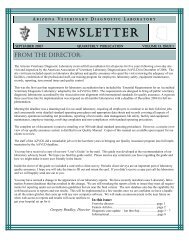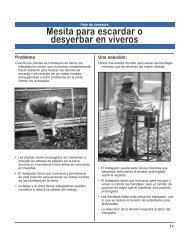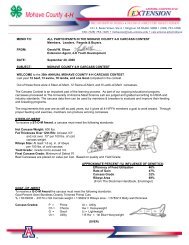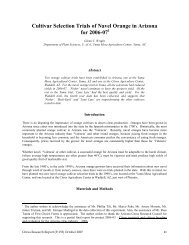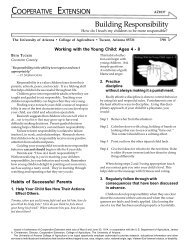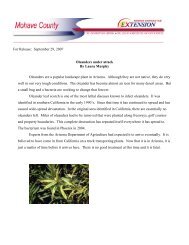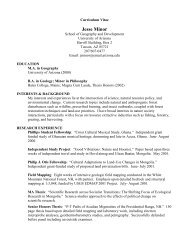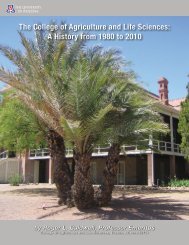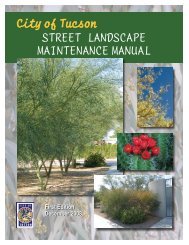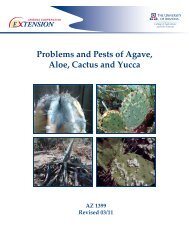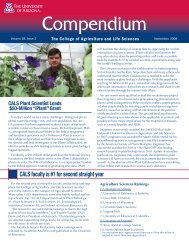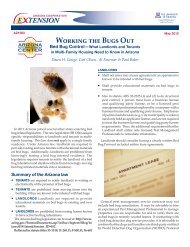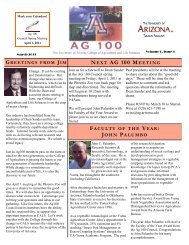Mesquite and Palo Verde Trees - University of Arizona
Mesquite and Palo Verde Trees - University of Arizona
Mesquite and Palo Verde Trees - University of Arizona
You also want an ePaper? Increase the reach of your titles
YUMPU automatically turns print PDFs into web optimized ePapers that Google loves.
native from central <strong>and</strong> southern <strong>Arizona</strong> into Mexico. It<br />
grows as a shrub on dry rocky upl<strong>and</strong> sites but will grow<br />
much larger under ideal conditions. This tree may be<br />
found as a single-stemmed tree in bosques (thickets) or as<br />
a multi-stemmed tree in open areas. The bark is fissured,<br />
dark brown <strong>and</strong> rough. The wood is prized for furniture<br />
because <strong>of</strong> its unique coloration <strong>and</strong> intricate grain. <strong>Trees</strong><br />
may grow up to 4 feet (1.2 meters) in trunk diameter <strong>and</strong><br />
live for several hundred years. Velvet mesquite foliage is<br />
covered with dense short gray hairs that cover most parts<br />
<strong>of</strong> a younger plant (Fig. 8).<br />
Filtered shade from velvet mesquites is light <strong>and</strong> <strong>of</strong>ten<br />
serves as a nurse tree for other slower growing plants such<br />
as cactus <strong>and</strong> shrubs. Leaves have one or two pairs <strong>of</strong><br />
pinnae (Fig. 8) with 12 – 30 pairs <strong>of</strong> leaflets each. In late<br />
fall or early winter after the first hard freeze, the graygreen,<br />
fine textured leaflets turn light green or tan <strong>and</strong> fall<br />
from the tree revealing a beautifully sculptured trunk <strong>and</strong><br />
scaffold branches. In spring two to three inch (5 – 7.5 cm)<br />
long cream-colored flowers adorn the tree followed by<br />
tan seed pods which ripen in mid to late summer. Young<br />
velvet mesquites have small thorns which become less<br />
problematic as the tree matures. Velvet mesquite trees are<br />
drought tolerant yet will flourish with moderate irrigation.<br />
They may become unstable due to rapid crown growth<br />
<strong>and</strong> a limited root system in lawn conditions.<br />
Hybrid mesquites<br />
<strong>Mesquite</strong>s cross-pollinate quite readily <strong>and</strong> as a<br />
result there are a group <strong>of</strong> plants that are simply called<br />
“hybrid mesquites”. They are <strong>of</strong>ten the result <strong>of</strong> natural<br />
hybridization <strong>of</strong> Prosopis alba (Argentine mesquite), P.<br />
chilensis (Chilean mesquite) <strong>and</strong> native P. velutina. Because<br />
<strong>of</strong> this hybridization, it is almost impossible to obtain pure<br />
species seed. Most hybrids are typically fast-growing,<br />
attractive, thorny or thornless, may have delicate blue<br />
green or green foliage or may have small leaves <strong>and</strong> have<br />
intermediate characteristics <strong>of</strong> the above described species.<br />
Many <strong>of</strong> the hybrid mesquite leaves persist until the new<br />
growth begins in spring, giving the tree an almost evergreen<br />
appearance. These hybrids are <strong>of</strong>ten sold in the trade as<br />
“Chilean” mesquite or “South American Hybrids”.<br />
Hybrid mesquites are noted for their rapid growth <strong>and</strong><br />
can attain a mature height <strong>of</strong> 9 – 40 feet (3 – 13 meters) with<br />
a spread <strong>of</strong> up to 30 feet (9 meters). They make an excellent<br />
large shade tree but given their size, are <strong>of</strong>ten unsuited<br />
for the smaller yards found in newer subdivisions. Many<br />
homeowners seek out the thornless hybrids <strong>and</strong> as a result,<br />
selections <strong>of</strong> trees having no thorns <strong>and</strong> superior structural<br />
<strong>and</strong> aesthetic characteristics have been made. To preserve<br />
these characteristics, trees either are grown from cuttings,<br />
are air layered, or are grafted. Thorns, which are modified<br />
leaves, <strong>of</strong>ten disappear as the tree matures. In situations<br />
where thorns (which can be up to 2 inches (5 cm) long) are<br />
objectionable, they may be pruned <strong>of</strong>f young trees <strong>and</strong> will<br />
not re-grow from this location again.<br />
4 The <strong>University</strong> <strong>of</strong> <strong>Arizona</strong> Cooperative Extension<br />
Culture<br />
All mesquites are very tolerant <strong>of</strong> hot south <strong>and</strong> westfacing<br />
walls, are valuable trees in parks or large public<br />
areas, <strong>and</strong> are an asset in low water-use l<strong>and</strong>scapes. They<br />
may be planted in groups or as solitary specimens <strong>and</strong><br />
add a lush appearance to the l<strong>and</strong>scape. <strong>Mesquite</strong>s are<br />
well suited to heat, low humidity, alkaline <strong>and</strong> poor soils.<br />
<strong>Mesquite</strong> trees are not well suited as street trees due to their<br />
multi-trunk character. The cold tolerance <strong>of</strong> many species<br />
has been established but this tolerance is quite variable<br />
owing to the condition <strong>of</strong> the plant at the onset <strong>of</strong> winter.<br />
Heavily fertilized <strong>and</strong> irrigated trees will not tolerate the<br />
cold as well as those that have been conditioned with less<br />
water <strong>and</strong> no fertilizer late in the summer. Honey mesquite<br />
(Prosopis gl<strong>and</strong>ulosa) <strong>and</strong> screwbean mesquite (P. pubescens)<br />
can survive temperatures to 0 ºF (–18 ºC); velvet mesquite<br />
(P. velutina) is reliably cold hardy to at least 10 ºF (–12 ºC);<br />
Chilean mesquite (P. chilensis) <strong>and</strong> black mesquite (P. nigra)<br />
are hardy to at least 15 ºF (–9 ºC); Argentine mesquite (P.<br />
alba) <strong>and</strong> many South American hybrids suffer damage<br />
<strong>and</strong> dieback when temperatures fall below 15 – 20 ºF (–9 to<br />
–7 ºC). Where there is abundant water present, mesquite<br />
specimens will be largest when grown in deep, uniform,<br />
s<strong>and</strong>y soils in <strong>and</strong> along streambeds, <strong>and</strong> alluvial plains.<br />
With proper irrigation, these trees will grow satisfactorily<br />
on any well drained soil.<br />
Problems<br />
Figure 9. True mistletoe aerial shoots with berries.<br />
There are few problems <strong>of</strong> mesquites. Mistletoe<br />
(Phoradendron californicum) can be a nuisance or develop<br />
into a more serious problem for heavily infested trees.<br />
True mistletoe contains chlorophyll <strong>and</strong> carries on<br />
photosynthesis, but being a parasite it also lives <strong>of</strong>f the<br />
nutrients <strong>of</strong> the host plant (Fig. 9). It can develop into<br />
plants that are several feet in diameter. Mistletoes may be a<br />
problem if left unmanaged <strong>and</strong> while it generally does not<br />
kill a tree, it can cause significant decline over time. If not<br />
pruned out, the weight <strong>of</strong> the mistletoe can become great<br />
enough that the branch may break <strong>of</strong>f. Manual removal



